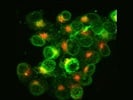
Technologies in next gen sequencing, tissue imaging, and RNA analysis have given rise to the frontier of spatial transcriptomics, a powerful technique for studying gene expression in the context of heterogeneous cells and tissue architechture.
Spatial locations of distinct cell subpopulations can directly influence their functions.
Such context is not adequately represented by sequencing techniques alone.
Spatial genomic and transcriptomic techniques measure expression levels of all or most genes systematically throughout tissue space, giving important insights into any tissue organization, differentiation, and localization.
The technique can be broadly grouped into two approaches: imaging-based or sequencing-based.
Imaging-Based Approach

Imaging-based approaches include situ hybridization-based methods, where imaging probes sequentially hybridized in the tissue, as well as in situ sequencing-based methods, where transcripts are amplified and sequenced in the tissue.
In situ hybridization applications detect specific RNA transcripts via hybridization of complementary fluorescent probes.
Sequencing-Based Approach

A limitation of probe-based methods is the requirement of a priori knowledge of gene targets. NGS approaches are thus less biased, as they seek to globally read all polyadenylated mRNA molecules. These methods build on single-cell RNA-Seq technology with the incorporation of barcodes to account for spatial position prior to library preparation. Spatially-barcoded RNAs are then processed for sequencing, where the barcode of each read is used to map the position, while the rest of the sequencing read is mapped to the genome to identify the transcript gene.
Recommended Resources:
-
Spatial genomics and spatial transcriptomics are rapidly evolving areas of research.
Over the past year, the field has exploded with the launch of multiplexed, high-throughput systems that can analyze tens of thousands of genes localized in a small section of the tissue.
-
Unlike conventional sequencing, in situ sequencing (ISS) is a method by which mRNA is sequenced directly in a section of fixed tissue or cell sample.
The ability to generate mRNA expression profiles with location information within tissues is a powerful tool.
Here is a look at some new ISS developments and applications.
-
New technologies for profiling the spatial expression of biomarkers for immune and cancer cells in the TME indicate avenues to improve the proportion of immunotherapy responders.
This article focuses on how spatial biomarker profiling of tumor samples is teaching researchers more about the TME, which may improve the effectiveness of cancer immunotherapy for more patients.
Manufacturers and researchers are working together to move forward.
Advances in technology are boosting the pace and power of research.
The specific goal of this experiment was to evaluate neurofilament light chain ...
When used for flow cytometry on iMC38 tumor-infiltrating immune cells, there ...
The MERSCOPE Platform is the first high plex, in situ single-cell spatial ...
The Sapphire FL Biomolecular Imager is a field-upgradable laser scanner, with a ...